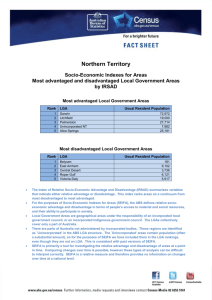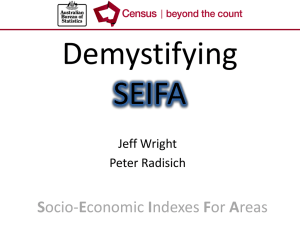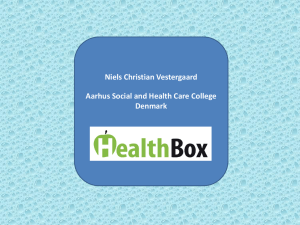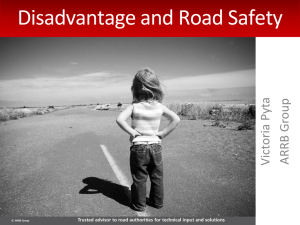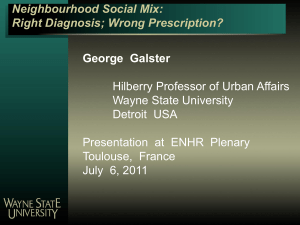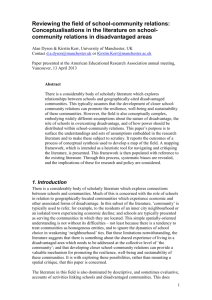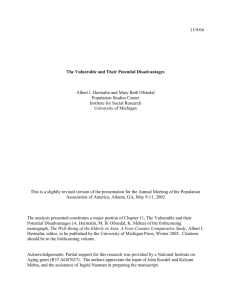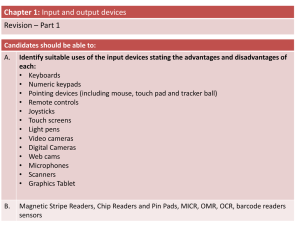PowerPoint summary of disadvantage in MLHD
advertisement
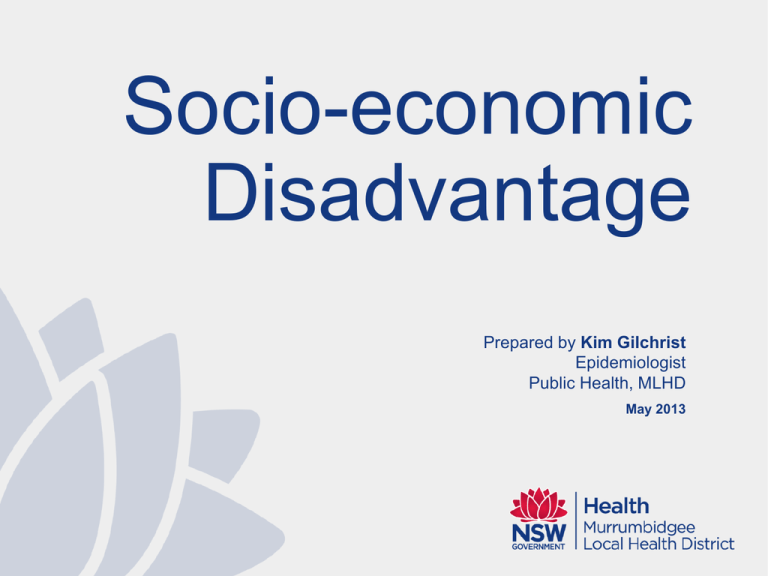
Socio-economic Disadvantage Prepared by Kim Gilchrist Epidemiologist Public Health, MLHD May 2013 Taking A “Social Determinants” Approach Research has shown that the housing, transport, stress, type of employment or unemployment, social support and income have as much impact on health and wellbeing as our genes and behaviours. These factors are known as the Social Determinants of Health are the conditions in which people are born, grow, live, work, play and age. Dahlgren and Whitehead's Social Determinants of Health Rainbow Source: Dahlgren and Whitehead (1991) Why look at disadvantage for health planning? Poorer people have poorer health People in disadvantaged areas have lower life expectancy and higher illness rates Need to identify if and where our District has areas of Disadvantage Identify areas of most need Enables targeted services How do we measure disadvantage? Many indicators in the Australian Bureau of Statistics Census: – Income – Disability – Housing – Car ownership – Employment – Internet access – Occupation – Qualifications – Family characteristics – English language skills How do we summarise all those? ABS developed summary measures combining many factors which can indicate economic or social disadvantage Australian Bureau of Statistics Socio Economic Indexes for Areas (SEIFA) Main one of interest is the: Index of Relative Socio-economic Disadvantage (IRSD) Index of Relative Socio-economic Disadvantage (IRSD) The ABS divides all Australia into small geographic areas They look at the percentage of people in each area in households with: – low incomes, no qualifications, low-skilled jobs, unemployment, poor English, one-parent families, overcrowded homes etc. Each area is given a score The areas’ scores are then ranked (ordered) and put into groups from 1 (most disadvantaged) to 10 (least disadvantaged). Index of Relative Socio-economic Disadvantage (IRSD) Each group contains 10 % of all the areas in Australia These are called Deciles Decile 1 Most disadvantaged 5 10 Least disadvantaged What is relative disadvantage? Relative – because this is an index comparing all areas across Australia relative to each other It is not saying that Decile 1 is “absolute poverty” but it has more households with the disadvantage characteristics and Decile 2 has less…. Decile 10 the least. The disadvantage scores cannot be compared to other countries or used as a measure of poverty, people in Decile 1 for example could not be said to be destitute or living in “developing world” conditions. Geographic Areas of MLHD 29 local government areas (LGAs) – plus part of Lachlan Shire (Lake Cargelligo) To give more specific detail we can look at: – ABS statistical areas (SA1s) – contain an average of 400 people – mostly within LGA boundaries – 787 SA1s in MLHD – Disadvantage scores are calculated at this level Geographic Areas of MLHD Disadvantage by LGA Most disadvantaged Decile 2 Least disadvantaged Disadvantage by LGA (cont.) Scores are averaged across the SA1s within the LGA Gives a good indication for MLHD which LGAs have relatively high proportion of disadvantaged Hay, Murrumbidgee and Narrandera stand out as the most disadvantaged LGAs Conargo shows as least disadvantaged However there is significant geographic variation in disadvantage within LGAs Disadvantage by Small Areas (SA1s) Scores are calculated across Australia at this level of geography Gives a good indication for MLHD of pockets of disadvantage within LGAs Each LGA can be looked at in more detail May help target location of certain services Disadvantage by SA1 Most disadvantaged Least disadvantaged Proportion of Disadvantage in LGAs ABS also releases data on the proportion of population in each LGA living in disadvantaged SA1s We can interpret this as the proportion of an LGA who are highly disadvantaged Narrandera, Harden and Lachlan Shire (Lake Cargelligo) have approximately one third of the LGA population living in highly disadvantaged areas. Disadvantage by LGA Most disadvantaged Least disadvantaged Population size or Percentage There may be a high percentage of population by LGA but small numbers of actual people – e.g. Lake Cargelligo Or the percentage might be small but there are high numbers of people e.g. Albury, Wagga Wagga Also shows where the population is – not just whole LGA e.g. Murray Shire has three separate locations of disadvantaged populations Disadvantage vs Health outcome SCATTER PLOTS SEIFA disadvantage score for an LGA (the horizontal axis) has been plotted against the rate of hospitalisation/death (the vertical axis) for that LGA. Each chart has 29 dots, one for each LGA. A “line of best fit” has been added to each chart to demonstrate a linear relationship between disadvantage and the health indicator.

